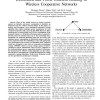718 search results - page 82 / 144 » Energy saving and network performance: a trade-off approach |
GISCIENCE
2008
Springer
13 years 9 months ago
2008
Springer
Dynamic geographic phenomena, such as forest fires and oil spills, can have dire environmental, sociopolitical, and economic consequences. Mitigating, if not preventing such events...
ICC
2007
IEEE
14 years 2 months ago
2007
IEEE
–The many-to-one traffic pattern dominates in sensor networks, where a large number of sensor nodes send data to one sink. A sensor node may only communicate with a small portion...
CN
2008
13 years 8 months ago
2008
Wireless sensor networks enhance our ability to monitor the physical world. Many recent researches on wireless sensor networks have focused on aspects such as routing, node cooper...
ICC
2009
IEEE
13 years 5 months ago
2009
IEEE
Most ad hoc mobile devices in wireless networks operate on batteries and power consumption is therefore an important issue for wireless network design. In this paper, we propose an...
ISLPED
2006
ACM
14 years 1 months ago
2006
ACM
Interprocessor synchronization, while extremely important for ensuring execution correctness, can be very costly in terms of both power and performance overheads. Unfortunately, m...

